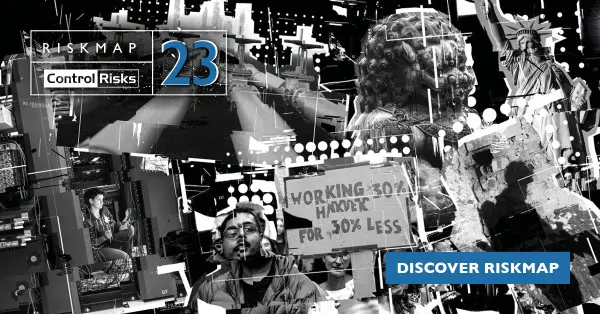Businesses will face a historically broad and deep set of risks in 2023, posing interconnected and existential threats across geographies and sectors, says specialist risk consultancy, Control Risks (www.ControlRisks.com).
Launching its annual RiskMap forecast featuring the Top Risks for business, Control Risks pointed to a combination of fractious geopolitics, armed conflict, disrupted energy systems, economic strife, and disarray in digital networks during the coming year.
The Top Risks for business in 2023 are:
- Defiance, decoupling and deconfliction in the US China relationship
- War, and all that goes with it
- Managing while adapting – surviving the energy disruption
- The end of global networks is coming
- Economic headwinds bring regulatory turbulence
Control Risks CEO, Nick Allan warned: “2023 will see more geopolitical and economic volatility accompanied by operational challenges in energy and digital networks.
The increasingly apparent effects of a changing climate will add additional stresses and strains. Resilience, insight, and courage will be the watchwords for business in the year ahead.”
Supporting the Top Risks for 2023 is a new map, the Global Risk Forecast, showing a holistic business risk rating for the countries of the world that draws on a selection of risks.
The composite score includes Control Risks’ political, security, operational, regulatory, cyber and integrity risks and includes a range of ESG-related risks. Each rating reflects Control Risks’ outlook for overall risks to business to the end of 2023, taking into account known or anticipated trends and developments that could impact the business environment.
The Top Risks for business in 2023
Geopolitical Risk – Defiance, decoupling and deconfliction in the US China relationship
The US-China relationship is the greatest geopolitical risk for businesses in 2023. Armed conflict between the US and China remains very unlikely in 2023, but competition and confrontation are moving from the trade and technology realms into the military domain.
Companies in 2023 must be alert to the prospect of an accident or miscalculation involving US and Chinese military vessels operating in Asia.
Businesses must monitor efforts to decouple critical supply chains. Rising bilateral tensions will not affect all companies equally. Strategic and high-tech sectors in both countries will face rising political risks; many in less sensitive industries will continue to experience business-as-usual conditions.
Security Risk – War, and all that goes with it
In 2023 war, or the prospect of war on several timelines and triggers should be high on everyone’s risk register. There will be continuing risk of escalation and overspill from the Ukraine-Russia conflict.
The complex commercial, operational, reputational, supply chain and sanctions risks from this war means many are considering what these would look like in the event of a conflict in East Asia.
The likelihood of such an event in 2023 is very low, but certainly significant enough to warrant the planning that many firms are now engaged in.
Beyond these spheres, proxy conflicts and perennial flashpoints could disrupt trade and energy security.
Operational Risk – Managing while adapting: surviving the energy disruption
Managing energy disruption while pursuing adaptation, will be the main operational risk to business in 2023. Energy has returned as the main driver of global disruption, and this will be a permanent, systemic change.
There will be no return to a pre-2022 stability and businesses should plan not only to survive the short-term price and supply shock, but how to thrive in a new, comprehensively re-wired, global energy system.
Companies will need a strategic approach to three key drivers of disruption that will shape business operations in 2023 and beyond: the weaponisation of energy; technological advances accelerating the energy transition and unavoidable decarbonisation targets.
Cyber Risk – The end of global networks is coming
In 2023, expect the emergence of a fundamental breakdown of global networks into distinct regional, or even national architectures, caused by the weaponisation of cyberspace and a clash of national interests. The ambition of operating a single, global network will be significantly challenged.
Enabled by an expanded attack surface and a significant increase in automation across the entire spectrum of cyber threats, the cyber arms race will accelerate in 2023.
In parallel to this weaponisation, states are looking to exert more control over what some have already defined as their national cyberspace. Network and system resilience will be tested like never before in 2023.
Regulatory Risk – Economic headwinds bring regulatory turbulence
Our top regulatory risk for the year is the turbulence caused by government responses to tougher economic conditions and fiscal fragility. Governments will be targeting revenue and striving to steady state finances. Wherever they turn, the corporate world will feel the heat one way or another.
Whether through windfall taxes, trade restrictions or protectionist supply-chain mandates, corporates will be targeted when governments need to shore up their finances and bolster populist credentials.
In some cases, regulatory changes will constitute a short-term pain, but governments may also seize the moment to make structural and long-term changes – to taxation, to investment rules, to trading restrictions.
